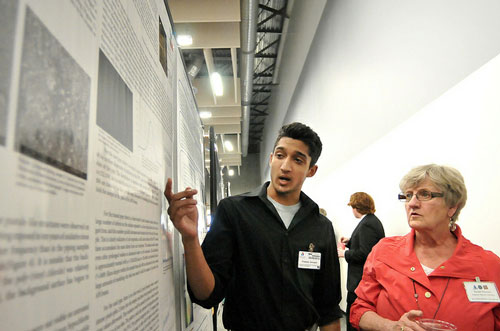| Jun 06, 2012 |
New program puts high school students in role of scientists
|
|
(Nanowerk News) In commencement speeches across the country, graduates have , been warned to expect rocky times breaking into the workforce. Unemployment hovers between 8 and 9 percent. Competition is tough.
|
|
Unless you studied science or engineering. Those jobs have a 2 percent unemployment rate, which has led some Fortune 500 companies to complain about offices they can't fill.
|
|
So it's no surprise that when the U.S. Department of Energy's (DOE) Argonne National Laboratory decided to give high school students a chance to test-drive a science career, it found students, parents and school officials from Naperville, Ill. eager to hop on board. Teachers received training in the workings of the Advanced Photon Source (APS), the brightest high-energy X-ray machine in the Western Hemisphere, and the Electron Miscroscopy Center (EMC). Students from Naperville's two high schools then competed for slots on four research teams that used X-ray beams to decipher what matter is made of, how it's built and how it reacts.
|
|
"This is a quantum leap from what they have done before," said Naperville North High School science teacher Beverly George. "We don't have the material to do an independent study program beyond what is available in a high school classroom. This introduces them to much more sophisticated equipment and a window on what they can do with it. It has whetted their appetites for what careers are out there."
|
 |
| APS Users Meeting poster session
|
|
More than 5,000 researchers from throughout the world use the APS and EMC annually to target society's greatest challenges: how to make better pharmaceuticals, sustainable fuels and high-performance materials. These challenges will feed scientific jobs for decades to come.
|
|
"I think there is a huge push in our district from the community for STEM (science, technology, engineering and math) education," said Tricia Noblett, a teacher and science club advisor at Neuqua Valley High School. "I think they are seizing on what has been out there in the media that STEM fields are where the jobs are and that science careers can be interesting."
|
|
Students drew on experiences in their lives to choose research topics and explained their results to scientists at the annual meeting held in May at Argonne for users of the APS, EMC and Center for Nanoscale Materials (CNM).
|
|
"The possibilities of science are limitless," said high school senior Avinash Prakash. "Science is continually growing. Through research we are part of a continuing process."
|
|
Inspired by the recent cleanup of a contaminated portion of the west branch of the DuPage River near their school, one group of students studied how to increase the efficiency of water filtration systems.
|
|
Another group worked with the Naperville wastewater facility to evaluate how corrosion affects the lifespan of water pipes.
|
|
And another group looked at how to improve the efficiency of graphene, a nanomaterial that may hold the key to building faster semiconductors for smart phones and the next-generation of research tools.
|
|
"We have realized how interesting it would be to go into a research career," said student Armita Manafzadeh. "I'm sad I'm a senior. I want to do it again."
|
|
Argonne hopes to expand the program to include more students next year.
|
|
"Kids need to be inspired before they get out of high school," said Louis Harnisch, education program coordinator for the Communications, Education and Public Affairs Division at Argonne. "They need to be given opportunities before they get to college so there is a more seamless transition, and they develop the confidence that they can do research. And, of course, we want to attract them to work here someday".
|

